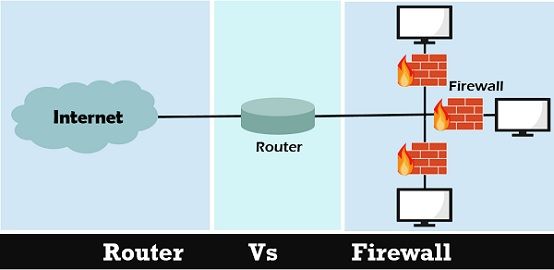Many of the repairs made to the personal computers and business computer networks RB’s Computer Service is called to fix, restore, and protect from malware attacks, ransomware, and hackers, could have been prevented had the homeowner or business owner had a firewall in place. Most of them think they do, and when we begin repairing the damage, they immediately point us to their router. On too many occasions the homeowner or business owner thinks the router is a firewall. They are surprised to learn routers and firewalls are different technologies and are used for accomplishing different tasks (TechDifferences, Staff Blog, Difference Between Router and Firewall, 2021, https://techdifferences.com/difference-between-router-and-firewall.html). To help clear up the confusion, let’s look at the difference between a router and a firewall. Finally, we have one recommendation regarding routers you can act on today to help protect your computer and network.
Most people know what they look like, the little box that blinks when their computer is online. A router allows you to connect to the internet, and when it is set-up correctly, stands as your first line of defense against network infiltration (TAILORD SYSTEMS, Staff Blog, The Differences Between Routers and Firewalls in Network Security, 2021, https://www.taylored.com/blog/the-differences-between-routers-and-firewalls-in-network-security/). Routers are like traffic cops navigating at a congested intersection. The intersection is your blinking router box. Its job is to look at each packet of data, read its source and destination IP addresses, find the destination IP in its routing table and then send each packet on its way in a systematic fashion. They also enable more than one computer in your network onto the internet. Password protection on your router can help prevent others from logging into it and changing the configuration and security settings. Without this protection in place, this opens the possibility for more exposure to security threats. An unprotected Wi-Fi network can be accessed by virtually anyone in range, but router security means more than password protection. This is where a firewall comes in.
If a router is your first line of defense, acting as a traffic cop, moving data into and out of your network, a firewall on the other hand stands between it and your computer network. The router may be able to thwart unwanted access to your “lane,” but does not stop a traveling virus smuggled through it. In this sense, a firewall is like customs or border patrol, “reviewing the credentials and intent of network traffic and allowing it in or out based on whether everything looks to be in order (TAILORD SYSTEMS, Staff Blog, The Differences Between Routers and Firewalls in Network Security, 2021, https://www.taylored.com/blog/the-differences-between-routers-and-firewalls-in-network-security/).” Lastly here, firewalls monitor and help block unauthorized traffic trying to come through the router into your network. Some firewalls even have anti-virus and anti-spam protection features, keeping your network safe from viruses and unwanted email (Barred Owl/WEB, Staff Blog, ROUTERS, SWITCHES & FIREWALLS: WHAT ARE THE DIFFERENCES?, August 12, 2013, https://barredowlweb.com/2013/08/12/routers-switches-firewalls-differences/).
In summary, a router and firewall are two different things, and the router is hardware to provide connections to various devices and get online. A firewall can be software or a hardware device, and it resides between the network and the system to monitor, and filter the data going in and out of the router (TechDifferences, Staff Blog, Difference Between Router and Firewall, 2021, https://techdifferences.com/difference-between-router-and-firewall.html). Many people think they have a firewall but just have a router. Both are necessary to protect your personal computers, business computers, and home or office networks. People often ask RB’s Computer Service which routers and firewall combos are the best, but the truth is it all depends. Contact us for a hassle-free consultation to help us learn about your system and needs. We would be happy to make a recommendation and help set it up. However, one recommendation we can make right here, if you plan to buy a new router anytime soon, choose a commercial-grade router over a consumer-grade router. Commercial-grade routers provide more security features.
devices and get online. A firewall can be software or a hardware device, and it resides between the network and the system to monitor, and filter the data going in and out of the router (TechDifferences, Staff Blog, Difference Between Router and Firewall, 2021, https://techdifferences.com/difference-between-router-and-firewall.html). Many people think they have a firewall but just have a router. Both are necessary to protect your personal computers, business computers, and home or office networks. People often ask RB’s Computer Service which routers and firewall combos are the best, but the truth is it all depends. Contact us for a hassle-free consultation to help us learn about your system and needs. We would be happy to make a recommendation and help set it up. However, one recommendation we can make right here, if you plan to buy a new router anytime soon, choose a commercial-grade router over a consumer-grade router. Commercial-grade routers provide more security features.
In addition to selling, and setting up routers and firewall systems, RB’s Computer Service offers Managed IT Service Agreements. For the best laptop computers, best desktop computers, business computers, computer parts, computer monitors, ransomware strategies, computer repair, iPhone, smartphone, and tablet repairs, contact us today at 763-441-3884 or via email at help@rbsmn.com. We serve customers and clients throughout central Minnesota and St. Cloud.



